SOCIAL WORK
Paper – II
Note : This paper contains fifty (50) objective type questions of two (2) marks each. All questions are compulsory.
1. In England which legislation for the first time overtook the powers of the church and transferred it to state ?
(1) Poor Law of 1601
(2) Statute of Labourers, 1349
(3) Emergency Appropriate Act, 1935
(4) Labour Exchange Act, 1909
2. The aim of ‘integrated social work’ is
(1) Growth and development of the individual members of community.
(2) Growth and development of the groups within the community.
(3) Growth and development of the community on the whole.
(4) Simultaneous growth and development of all the above.
3. Which among the following is/are elements of Social Group Work ?
(i) Enhancing social functioning.
(ii) Purposeful group experience.
(iii) Coping effectively with personal, group or community problems.
(iv) Guided group interaction.
Codes :
(1) (i) and (iv) only
(2) (ii) and (iii) only
(3) (i), (iii) and (iv) only
(4) (i), (ii), (iii) and (iv)
4. Theory of ‘Will’ was developed by
(1) Freud
(2) Carl Jung
(3) Otto Rank
(4) Alfred Adler
5. Which among the following are models of Social Group Work ?
(i) Remedial Model
(ii) Mediating Model
(iii) Developmental Model
(iv) Social goal Model
Codes :
(1) (i) andü (ii) only
(2) (ii) andü (iii) only
(3) (ii), (iii) andü (iv) only
(4) (i), (ii), (iii) andü (iv)
6. Which is not a type of marriage ?
(1) Polygyny
(2) Monogamy
(3) Misogyny
(4) Polyamory
7. Who classified societies into ‘simple, compound, doubly compound, trebly compound’ ?
(1) Karl Marx
(2) Aguste Comte
(3) Herbert Spencer
(4) Sorokin
8. Which of the following concepts are/is not associated with Sorokin’s classification of societies ?
(1) Ideational
(2) Eclectic
(3) Sensate
(4) Idealistic
9. The aim(s) of Social Justice is/are to promote :
(i) Social Justice
(ii) Social Security
(iii) a just social order
(iv) Social Action
Codes :
(1) (i) and (iv) only
(2) (ii) and (iii) only
(3) (i), (ii) and (iii) only
(4) (i), (ii), (iii) and (iv)
10. Social Defence deals with
(a) Suppression of immoral traffic.
(b) Prevention and control of drug abuse.
(c) Protection of aged.
(d) Cross border terrorism.
Codes :
(1) (a) only
(2) (a) and (b) only
(3) (a), (b) and (c) only
(4) (a), (b), (c) and (d)
11. The co-founders of the Hull House in Chicago established in the year 1989 were :
(1) Kathleen Woodroofe and Jane Adams
(2) Jane Adams and Ellen Gates Starr
(3) Richard Titmuss and Ellen Gates Starr
(4) Jane Adams and Beatrice Webb
12. Which one of the following is not central to social work as for global definition of 2014 ?
(1) Social Service
(2) Principles of Social Justice
(3) Collective responsibility
(4) Respect for diversities
13. Protection of Children from Sexual Offences (POCSO) Act was enacted in
(1) 2011
(2) 2012
(3) 2013
(4) 2014
14. Which of the following homes is not the part of Juvenile Justice Act, 2015 ?
(1) Observation Home
(2) Shelter Home
(3) Special Home
(4) Protective Home
15. Kurt Lewin is related to
(1) Field Theory
(2) Exchange Theory
(3) Learning Theory
(4) Conflict Theory
16. W.S. Gosset developed
(1) chi-square test
(2) Z-test
(3) t-test
(4) u-test
17. The function where in the efforts are made to eliminate factors causing or precipitating the breakdown of social functioning is known as
(1) Rehabilitative function
(2) Developmental function
(3) Educational function
(4) Curative function
18. The division of unit/population into homogenous subgroups is
(1) Convenient sampling
(2) Purposive sampling
(3) Data sampling
(4) Stratified sampling
19. Who has advanced the Goal setting theory of Performance Management ?
(1) E.A. Locke
(2) F. Thrmpenaavs
(3) R. Tung
(4) J.C. Usanier
20. Community based services to offer support to substance abusers consists of self-help services such as
(1) Narcotic Anonymous
(2) Crack Crack
(3) Cannabis Collective
(4) Hashish Home
21. Theory based on the material interpretation of history is known as
(1) Functional
(2) Structural
(3) Marxist
(4) Behavioural
22. Which among the following does highlight the interrelationships between different people in a group ?
(1) Sociogram
(2) Clique
(3) Group cohesion
(4) Group bond
23. Restorative Justice means making amends to
(1) The victim or the society for the harm resulting from a criminal offence.
(2) The legal system to correct the behaviour of criminals.
(3) The prison environment.
(4) The social environment of the victim.
24. Assigning numbers to the various categories of a variable to be used in data analysis is called
(1) Coding of data
(2) Classification of data
(3) Tabulation of data
(4) Distribution of data
25. Paulo Freire’s approach could be briefly stated as
(1) Organization of services for people
(2) Mobilization of community leaders
(3) Action-reflection process with people
(4) Identification of target system for work
26. Who among the following made a distinction between gemeinschaft and geselleschaft as far as personalised and anonymous communities are concerned ?
(1) Robert MacIver
(2) Margaret Mead
(3) Ferdinand Tonnies
(4) William Sumner
27. What are the major components of “Digital India” ?
(i) Digital infrastructure
(ii) Digital analysis
(iii) Digital literacy
(iv) Digital delivery of services
Codes :
(1) (ii), (iii) andü (iv) only
(2) (i), (ii) and (iii) only
(3) (i), (iii) and (iv) only
(4) (iii) and (iv) only
28. Which of the following is not a form of Social Security ?
(1) Social assistance
(2) Social action
(3) Social insurance
(4) Public assistance
29. Reducing the number of employees at operational level and reorganising the work system in order to attain greater productivity is
(1) Right sizing
(2) Manpower inventory
(3) Manpower forecasting
(4) Human Resource Audit
30. Rogers’ personality theory falls under which one of the following ?
(1) Existential Psychology
(2) Psychoanalytic Psychology
(3) Humanistic Psychology
(4) Behaviourism
31. “Sugamya Bharat Abhiyan” (Accessible India campaign) is related to which of the following areas ?
(1) Disability
(2) School Education
(3) Cleanliness
(4) Black Money
32. Herbert Spencer viewed all evolution in terms of two types of Society, namely :
(1) Agrarian and Industrial
(2) Military and Industrial
(3) Pastoral and Industrial
(4) Tribal and Industrial
33. Which among the following statements are wrong with regard to Kyoto Protocol ?
(1) Kyoto Protocol was adopted in 1997.
(2) The first Commitment period of Kyoto Protocol ended in 2012.
(3) Kyoto Protocol is about reduction of emissions of Greenhouse Gases.
(4) The second commitment period of Kyoto Protocol will end in 2030.
34. The Street Vendors (Protection of Livelihood and Regulation of Street Vending) Act, 2014 defines a mobile street vendor as a
(1) person who offers goods or services for sale to public in a street without having a permanent built-up structure.
(2) person who occupies pavements or public/private spaces for vending activities.
(3) person who carries out vending activities in designated areas by moving from one place to another.
(4) person who vends with the RWA.
35. According to International Covenant on Civil and Political Rights (ICCPR), which of the rights are non-derogable rights
(i) The Right to life.
(ii) The Right to be free from slavery and servitude.
(iii) The Right to be free from torture and other inhumane treatment.
(iv) The Right to marry and found a family.
Codes :
(1) (i), (ii) andü (iii) only
(2) (ii), (iii) and (iv) only
(3) (i), (ii) and (iv) only
(4) (i), (ii), (iii) and (iv)
36. Arrange the sequence as per the stages involved in adoption of a child in India.
(1) Registration, Home Study Report, Court order, matching the child with parent, preadoption foster care.
(2) Registration, matching the child with parent, Home Study Report, Court order, preadoption foster care.
(3) Registration, Home Study Report, Matching the child with parent, Pre-adoption foster care, Court Order.
(4) Registration, Matching the child with parent, Home Study Report, Court Order, preadoption foster care.
37. Assertion (A) : Social work profession in India is in a state of crisis-identity, competence and credibility.
Reason (R) : Unregulated rapid expansion of social work educational institutions in the absence of an effective national level professional organization has led to massive outflow of social work graduates.
Codes :
(1) Both (A) and (R) are correct and (R) is the correct explanation of (A).
(2) Both (A) and (R) are correct, but (R) is not the correct explanation of (A).
(3) (A) is correct, but (R) is not correct.
(4) (A) is not correct, but (R) is correct.
38. Assertion (A) : Rural development programmes suffer from lack of effective monitoring and evaluation.
Reason (R) : Rural development administration is deficient in Professionalism and have multiplicity of authorities.
Codes :
(1) Both (A) and (R) are correct and (R) is the correct explanation of (A).
(2) Both (A) and (R) are correct, but (R) is not the correct explanation of (A).
(3) (A) is correct, but (R) is not correct.
(4) (A) is not correct, but (R) is correct.
39. Assertion (A) : If a person feels that his Fundamental Rights have been infringed, he/she can approach court of law for his/her right.
Reason (R) : Fundamental Rights are justifiable.
Codes :
(1) Both (A) and (R) are correct and (R) is the correct explanation of (A).
(2) Both (A) and (R) are correct, but (R) is not the correct explanation of (A).
(3) (A) is correct, but (R) is not correct.
(4) (A) is not correct, but (R) is correct.
40. Assertion (A) : Marx provided a clear description of capitalism and class.
Reason (R) : Marx has provided the motivation for working-class people to join together and improve their position in society.
Codes :
(1) Both (A) and (R) are correct.
(2) Both (A) and (R) are not correct.
(3) (A) is true, but (R) is false.
(4) (A) is false, but (R) is true.
41. Match the List-I with List-II and choose the correct answer from the codes given.
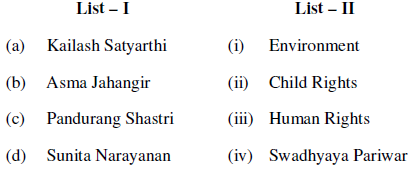
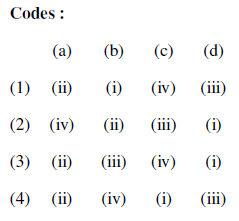
42. Match List-I with List-II and select the correct answer from the codes given :
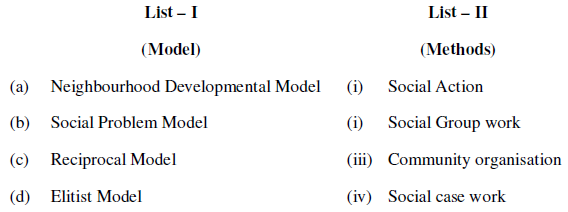
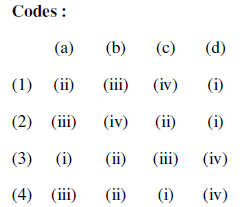
43. Match List-I with List-II and give the correct answer from the given code :
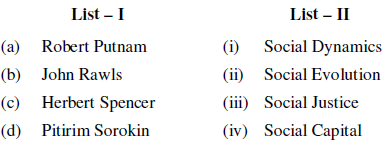
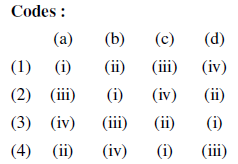
44. Match List-I with List-II and give the correct answer from the given code.

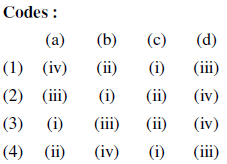
45. Assertion (A) : Community organisation is popular method of Social work in India.
Reason (R) : Indian Society share their personal issues and problems within family and community members.
Codes :
(1) Both (A) and (R) are not true.
(2) Both (A) and (R) are true.
(3) (A) is not true, but (R) is true.
(4) (A) is true, but (R) is not true.
Read the passage given below and answer the following questions (46-50) as per the understanding of the passage.
Traditionally, many of the human service agencies have focused on trying to better understand the biological/psychological or environmental risk factors that increase the likelihood of the development or maintenance of risk behaviour and the potential implications for prevention. Interventions that are based on the deficit, problems, or pathologies of individuals tend to direct the attention of professionals to only one view of the person. This in turn has led to the conclusion that community or school intervention and prevention programs need to focus on risk reduction by helping those they serve to develop more effective coping strategies or alignment with prescribed support resources.
The emphasis on deficits or what a person is lacking, leads to a cycle of focusing only on what needs to be repaired followed by a reliance on prescribed resources or assumed solutions. However, when care providers or organizations act as experts on resolving the problems of people, we deny and limit those particular individuals facing the problem the opportunity to explore what strengths and capacities they might have in the process of exploring, participating, taking control and learning.
Strengths-based approaches concentrate on the inherent strengths of individuals, families, groups and organisations, deploying personal strengths to aid recovery and empowerment. The strengths approach as a philosophy of practice draws one away from an emphasis on procedures, techniques and knowledge as the keys to change. It reminds us that every person, family, group and community holds the key to their own transformation and meaningful change process. The real challenge is and always has been whether we are willing to fully embrace this way of approaching or working with people. If we do, then the change needs to start with us, not with those we serve.
Embracing a strength based approach involves a different way of thinking about people and of interpreting their patterns of coping with life challenges. With a strength based mindset, one asks different questions and communicates in ways that invites a curious exploration based upon a clear set of values and attitudes. The belief that “the problem is the problem; the person is not the problem” is an important point to understand from a strengths perspective. Rather than framing the person as the problem, one approaches individuals as being affected by or robbed of opportunities by the problem.
The strengths-based cycle begins with a more holistic focus that includes an emphasis on a person’s strengths and resources (internal and external) in the process of change. When challenges are experienced, problems and issues are acknowledged and validated, and strengths are identified and highlighted. This strengths exploration changes the story of the problem as it creates positive expectations that things can be different and opens the way for the development of competencies.
46. What has been the focus of intervention of the human service agencies traditionally ?
(1) To understand development or maintenance of risk behaviour.
(2) To understand the potential implications for prevention.
(3) To direct the attention on only one view of the person.
(4) Risk reduction by developing coping strategies and alignment with support systems.
47. What are the limitations of interventions based on deficits ?
(1) In such interventions, care providers act as experts.
(2) Focus is only on assumed solutions.
(3) Individuals facing problems are denied the opportunity to explore their strengths and capacities.
(4) Reliance on prescribed resources.
48. What is the point of departure of the strength based approach from that of the traditional intervention approaches of social work ?
(1) It concentrates on the inherent strengths of the individuals, families, groups and organizations.
(2) It embraces a different way of thinking about people.
(3) It lays less emphasis on procedures, techniques and knowledge as the keys to change.
(4) It is based on the belief that the problem is the problem, the person is not the problem.
49. How would you understand the belief “the problem is problem; the person is not the problem” from a strength perspective ?
(1) The person is not responsible for the problem.
(2) The problem has to be assessed by itself rather than the individual.
(3) Person is framed as the problem.
(4) Problem affects or robs the individual of opportunities.
50. In strength-based approach, the key to the change process is
(1) Person
(2) Problem
(3) Place
(4) Process
Latest Govt Job & Exam Updates: